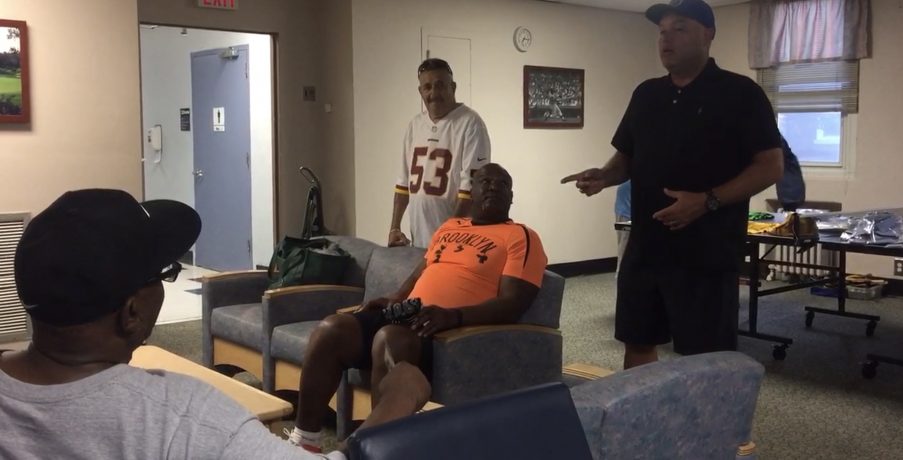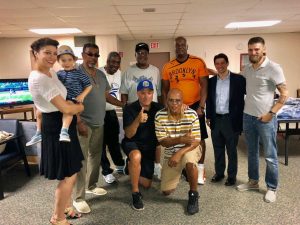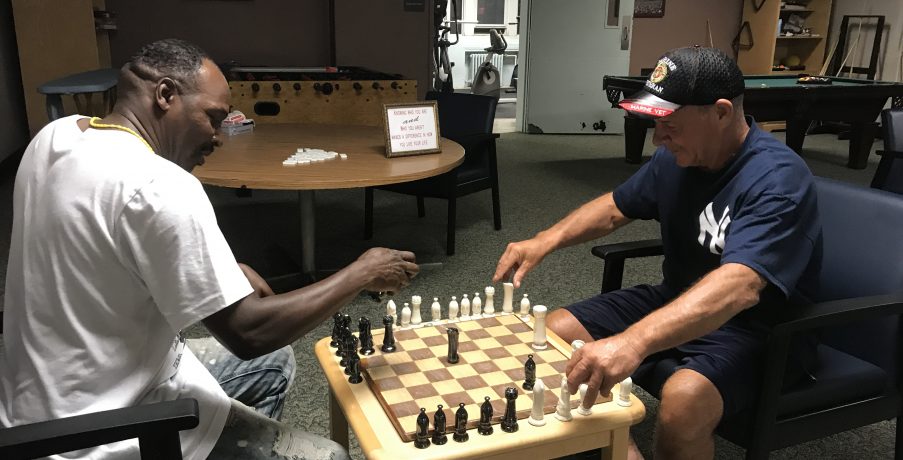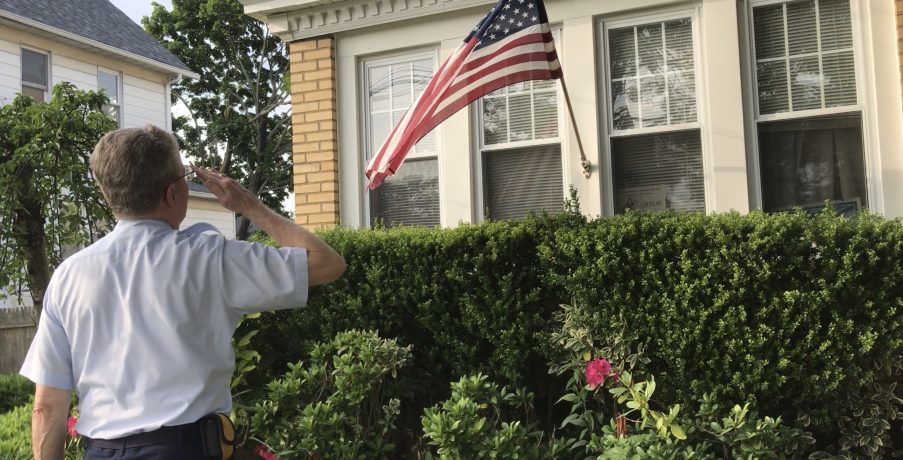
Neil A. Carousso produces NewsNation original “Kurt’s Country” – a celebration of country music and a slice of Americana with host Kurt Bardella.
-
50th U.S. Open Gets Underway in Queens
Post Views: 1,333NEW YORK (WCBS 880) — The top tennis players in the world have descended on Queens for the 50th US Open.
There’s been a lot of stress and anxiety, but the $500 million rebuilding of the tennis center at Flushing Meadows is finally complete.
From @wcbs880 #Chopper880: The #BillieJeanKing #NationalTennisCenter is ready for you! @bradheller14's live reports from the #USOpen begin this morning on #WCBS880; 08.27.18; #Queens; #NYC; #ArthurAsheStadium; #LouisArmstrongStadium; @USTANTC; @usta; @usopen; @Radiodotcom pic.twitter.com/Kdd5MFsEGp
— Tom Kaminski (@TomKaminskiWCBS) August 27, 2018
“This is our capstone year. We have been under construction essentially for six years, taking a break each year to stage the US Open,” said tournament director David Brewer.
There are now two roofs on two stadia at the center, but they will only close for rain, not heat.
“At the end of the day, this is an athletic contest and we want to make sure that we are fair to our players and that they have a level playing field,” Brewer said.
Ready for action as the 50th @usopen begins in Queens. There’s a new Louis Armstrong Stadium to go with the existing Arthur Ashe. I’m with @bradheller14 and @NeilACarousso. @wcbs880 pic.twitter.com/tckglVNJpz
— Peter Haskell (@peterhaskell880) August 27, 2018
The new 14,000 set Louis Armstrong Stadium has a retractable roof, similar to the one installed at the Arthur Ashes Stadium for the 2016 event.
But that’s the only thing that’s different at the new stadium.
https://www.facebook.com/wcbs880/videos/253663922143896/?hc_ref=ARSPiIgvwVmO7J7OVrCvcRqutZXQV5NW8s7C90NsWhx_Wn4Q4KPKIC2H2AAJF7wQE-8&__xts__%5B0%5D=68.ARCg8KZwcJffZUfKq9bs9G7i7MwSyRN70IMjuH34hmbkZY7d__TrEYKHMZ3kvRN13Dn1nUYtvz7LIc1lpJ30KXVEHaWKa7AydLY40szCwJ6IuCDgYiacqKJBkacWMyqlVCjfx8w&__tn__=FC-R&fb_dtsg_ag=AdxhxlFVAfUCv-g3smc0BunwbzXxg5HwQQK2jCobgn9l0A%3AAdx-XbDE3ClQHWKNd4rNR3ta3Eqe_GSp8Kile6rdSE-Bew
“What you see when you first walk in here is nothing but concession stands and restrooms — the two things that every stadium needs to have and we have those in abundance now at both levels,” Brewer said.
There are also new flowers and more trees to provide extra shade at the grounds.
https://www.facebook.com/883305061792138/posts/1693529650769671/
On day one of the U.S. Open, there has already been an upset. Simona Halep, who won the French Open in June, was beaten by 44th-ranked Kaia Kanepi of Estonia, becoming the first No. 1-seeded woman to lose in the first round of the tournament.
“It was amazing,” said Rebecca Franson of Idaho, who watched as a top seed was knocked out in the opening round for the first time.
Tim Mercado of Brooklyn Heights likes to root for the underdogs.
“These people out there are just really busting it to get it done, and they’re doing it – they’re not making it billions and millions; they don’t have a million sponsors like wanting them to do this, and you know, being able to come and go out on the courts and just go from court to court to support them, I think that’s important,” Mercado said.
Mercado thinks this is the best day of the tournament, when you can see top players on every court.
It was the first match to be held at the newly rebuilt Louis Armstrong Stadium.
Neil A. Carousso is producing multi-media content from the U.S. Open Grand Slam Tennis Tournament for WCBS Newsradio 880.
-
Two-Time Giants Super Bowl Champ Sean Landeta Spends A Night with Our Heroes
Post Views: 1,338By Neil A. Carousso, Special to ConnectingVets.com and WCBS Newsradio 880
NORTHPORT, N.Y. — A humble 6-foot Giant walked into the Department of Veterans Affairs Medical Center on Long Island Thursday evening wearing his 1986 Super Bowl ring and a debt of gratitude on his sleeve.
“It really gives me chills to think of what they did and why we’re able to live how we do here to come and see the veterans and talk to them and hear their stories,” retired NFL punter Sean Landeta said.
He won two Super Bowls with the New York Football Giants at the conclusion of the 1986 and 1990 NFL seasons. Landeta is an All-Pro and All-Decade Team punter who played 22 seasons – the longest tenure in league history for his position – in the National Football League, mostly with the Giants. He also played for the Rams, Buccaneers, Packers and Eagles.
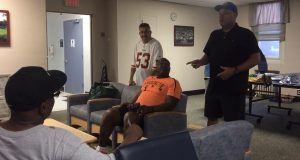
Retired NFL All-Pro Punter Sean Landeta talks football with veterans at the Northport VA. (Neil A. Carousso/ConnectingVets.com/WCBS Newsradio 880) Landeta is known for pinning the opposing team inside the 20 yard line; he retired with the league record for doing so, and he is currently number two on the all-time record list for most punts inside the 20, second to retired Giants punter Jeff Feagles, Landeta’s successor.
He recalled an amusing story he told a group of veterans, who surrounded him to talk football, of the moment he thanked legendary G-Men quarterback Phil Simms on the sideline of Super Bowl XXI for throwing a couple incompletions that gave Landeta an opportunity to appear in the big game against the Denver Broncos. He told the vets he wanted his family to get to see him play in the big game in person at the Rose Bowl in Pasadena, California. Simms, the Super Bowl MVP, actually set a record for completing 22 of 25 passes, leading Big Blue to victory over the Broncos 39-20.
From the moment Landeta walked in to the building where the veterans live on the Northport VA Medical Center campus, they were fascinated by his playing career, but Landeta was awestruck by the true heroes around him.
“As a player, people are always asking you about you, and you know, I’ve had such good times just asking these guys: ‘tell me about you and where you’ve been and what you’ve done,’” Landeta said, adding, “It really humbles you to see what they’ve done and makes you realize how lucky we are to have heroes like this.”
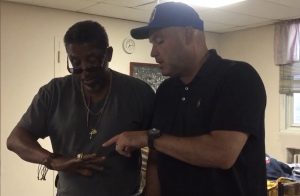
Sean Landeta lends his 1986 Giants Super Bowl ring to a veteran at the Northport VA. (Neil A. Carousso/ConnectingVets.com/WCBS Newsradio 880) It was a casual night that will stay with those men forever. They took pictures with Landeta wearing his Super Bowl ring on their fingers, watched preseason football on the television, and sat and talked about their services and their current day-to-day struggles.
At the end of the night, everyone was smiling.
“A lot of them seem like they’re in a pretty good place. I really enjoyed my time with them. I hope I can come back again.”
-
Two Veterans Open Up About The Realities of Service
Post Views: 1,471By Neil A. Carousso, Special to ConnectingVets.com and WCBS Newsradio 880
NORTHPORT, N.Y. — As the sun set on a beautiful Thursday evening at the U.S. Department of Veterans Affairs campus on the North Fork of Long Island, a group of veterans finished their first yoga session and enjoyed dinner together before sitting down in their recreational room to watch the New York Yankees host the Kansas City Royals on television.
It was a light-hearted evening discussing the latest sports news as a distraction for the veterans’ personal struggles since returning home.
“Boot camp was great. I went in at 17. [It] toughened me up to be a man,” said Andrew Brand, a U.S. Marine Corps veteran who served from 1981-83.
Just moments before he offered to speak on camera about his service in the Marines, Brand was passionately discussing New York sports, including his love for the Yankees, Rangers hockey, Knicks and Giants football, and lighting up the room with his larger-than-life personality and friendly jocularity. Then, he turned serious.
“[I] came home on leave prior to going to Beirut and I got in a car accident and I was in a coma for 32 days and I was read my last rights by a priest,” Brand said, continuing, “And, October 23, 1983, they car bombed two barracks, 220 Marines were dead and I would have been there.”
A group called the Islamic Jihad claimed responsibility for the Beirut barracks bombings – a terrorist attack on United States and French service members on a peacekeeping mission during the Lebanese Civil War. It was the deadliest attack against the U.S. Marines since the battle over Iwo Jima in February 1945.
“They’re brothers,” Brand said as he acknowledged he thinks of them often.
Brand is recovering at the Northport VA Hospital from alcoholism. One day, his 14 year old daughter confronted him after returning from a bar and asked him to seek help. He checked himself in at the VA about 8 months ago and he will be returning home to his family in Sayville on Long Island where his daughter and 8 year old son, Andrew, Jr., live.
Brand has kept himself in good shape physically and mentally, exercising daily and eating a healthy and consistent diet as if he was still standing a post – six eggs every morning for breakfast and tuna for lunch and dinner. He is adamant about successfully finishing his recovery and avoiding relapse. As Brand says, “Family first.” Brand has been sober since he checked himself in.
As a Marine, Brand is trained to look out for his cohorts. He shared experiences with Army veteran Donail Sykes who is recovering from a substance abuse issue compounded with PTSD.
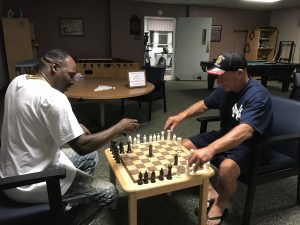
Army Veteran Donail Sykes (left) and Marine Corps Vet Andrew Brand play a game of chess at the Northport VA Medical Center. (Neil A. Carousso/Entercom) “I’m working on it and I’m fighting back and I’m doing well and I’m about to complete this program, but as far as completing the problem I had, it’s a never-ending problem, it’s forever, so I’m working on staying clean every day,” Sykes said.
He is returning home to New Jersey in a few days where he has two supportive brothers and two loving sisters waiting for him, hoping he takes the lessons on stress and coping with PTSD that resonated with him to daily practice when he leaves the VA hospital.
“You know, it’s an every day struggle, but I get through it. I’m getting better now. They give me a lot of training,” said Sykes.
Both veterans said positivity and sharing their experiences with their fellow vets who can relate and understand their tribulations are therapeutic.
“Prayer has helped me a lot,” said Brand who makes it a weekly practice to attend Sunday mass with The Greatest Generation on the other side of the VA campus. He then walks the World War II veterans, many with missing limbs, back to their rooms and spends time talking to them. “It gives me a great feeling inside and they’re very happy that they have someone to talk to and it’s a great experience.”
Each veteran has a story that begins with tremendous sacrifice, and often times, all they need is a welcoming ear to listen.
-
What Veterans Need to Know about Buying a Home
Post Views: 1,741By Neil A. Carousso, Special to ConnectingVets.com and WCBS Newsradio 880
HAUPPAGE, N.Y. — Corporal DaMel Williamson (Ret.) made a common mistake about 8 years ago after he was honorably discharged from the U.S. Marine Corps and pursuing home ownership.
“I had a son in 2010. That was the next thing on my brain: I needed a house,” said Cpl. Williamson, who served active duty in Operation Iraqi Freedom and Operation Enduring Freedom where he was the senior corporal in charge of the 203 Motor-T Marines with three non-commission officers.
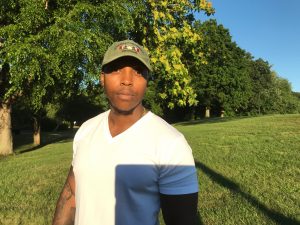
Cpl. DaMel Williamson (Ret.) poses for a picture at the Veterans Memorial in Suffolk County, New York. (Neil A. Carousso/Entercom) His initial mistake was getting a Federal Housing Administration (FHA) loan through a bank rather than a Veterans Affairs (VA) home loan – a benefit of which active duty veterans who serve 90 consecutive days during wartime, like Cpl. Williamson, are eligible. Other eligible veterans include those who have served 181 days of active service during peacetime, vets who served more than 6 years in the National Guard or Reserves and spouses of service members who died in the line of duty or as a result of a service-related disability.
“When you’re in the Marines, it’s just Marines,” said Cpl. Williamson who added that the was informed of his benefits, but when he sought out information, he wasn’t guided or educated on the benefits of using the VA loan rather than the FHA loan.
“He could have easily went VA, he could have easily had a lower rate, he could have easily saved the money per month by not paying the PMI (Private Mortgage Insurance),” said Michael Aharoni, who founded VetsEDU after his grandfather, an Army veteran, passed away in November 2015.
“He had the whole military funeral and something just clicked inside my head and I wanted to do something to give back to him to give back to the brave men and women that protect us every single day,” said Aharoni of honoring his grandfather’s legacy. “You fought for us, you fought for our country, you deserve the benefits that you receive.
Aharoni works from Hauppauge on Long Island, but he travels around the country teaching veterans. VetsEDU now operates in 16 states, partnering with veteran and military groups. It is the largest non-profit military real estate educational organization in the nation.
Aharoni’s goal is to pass legislation to make home buying education a requirement for veterans to protect them from realtors and banks who may not be motivated to have veterans in their best interest. He was in Washington, D.C. meeting with several members of Congress two weeks ago.
When Cpl. Williamson achieved his American Dream of home ownership, Aharoni brought him on the board of VetsEDU to educate his peers on what he mastered.
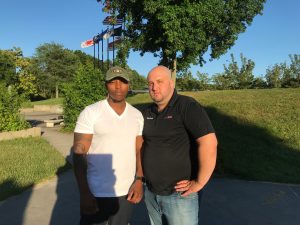
Cpl. DaMel Williamson (Ret.) and VetsEDU Founder Michael Aharoni (Neil A. Carousso/Entercom) “I just get them to understand that they are eligible and won’t be lost like I was trying to get a FHA [loan] when you have this great thing in your pocket,” said Cpl. Williamson.
Other board members include Major Gen. Marta Carcana (Ret.) who was the first Puerto Rican woman adjunct general let alone major general to serve in the U.S. Military. Major Gen. Carcana’s service spans 31 years in the Army Reserve and National Guard, with active duty in Kosovo.
“Through a mutual friend, Mr. Aharoni and I met. He told me the story, he came to Puerto Rico to visit me, to meet me, to see that I was real and that I was not a make-believe story,” said Major Gen. Carcana via Skype from her home in Puerto Rico who joined VetsEDU out of inspiration and a passion to continue serving the nation while her son is in the Puerto Rican National Guard.
“Michael gave me the opportunity to serve, to serve those that served, and what better [way] than that – not to lose contact with the people you were in contact with for 31 years, not to lose contact with what you are,” added Carcana.
“My family is my veterans and I hate to see a vet not having or don’t know,” Cpl. Williamson said of his role with VetsEDU. “When I help my vets, I know I’m doing them a good thing.”
5 Things Veterans Should Know about Buying a Home:
1. Not every bank is equal
VetsEDU Founder Michael Aharoni says banks charge fees of which veterans should not pay. He explains banks have a VA approval process and some are better than others in honoring those who served and scaling back unnecessary fees.
In addition, banks will work with vets when they are ready to purchase a home; whereas, VetsEDU begins working with veterans even a year before they are ready, educating veterans on the approval process and helping them and their families develop their budget and improve their credit scores.
2. Not every realtor is equal
Aharoni is a licensed real estate broker with the designation of MRP that stands for Military Relocation Professional. Veterans should work with realtors with that certification and experience who understand the ins and outs of the VA Loan.
3. Not every house is equal
“You cannot use a VA Loan on a co-op,” Aharoni said, adding that not every condo is VA approved. Your MRP-certified real estate broker will be able to guide you in the right direction as you begin this process.
There are minimum requirements of homes to be approved by the Department of Veterans Affairs. Aharoni says a basic rule of thumb is that homes with little renovations needed are likely to be approved.
4. You can secure a VA loan with low credit and income.
While credit and income are important in securing a loan approval, the VA Loan is “much less strict than your conventional loan,” said Aharoni who guides veterans with low credit and income meet the basic requirements and stay on top of payments with an action plan.
5a. VA Loan is the easiest to close and be accepted.
“The VA Loan is probably the fastest loan to close,” Aharoni said, adding it may only be 30-60 days before the loan closes. Veterans put no money down on the VA Loan, but some sellers ask for one to put down a good-faith deposit that will go towards the closing cost if the seller wants to see proof the veteran has the financial wherewithal to hold up his or her end of the deal.
5b. Have the right team in place!
You can learn more about VetsEDU and contact Michael Aharoni for more information through their website, VetsEDU.org.
-
Proud Air Force Vet of 4 Decades Pays Lifelong Homage to the American Flag
Post Views: 1,451By Neil A. Carousso, Special to ConnectingVets.com and WCBS Newsradio 880
VALLEY STREAM, N.Y. — Whenever James Cunningham sees the American flag, he salutes.
Cunningham is a retired senior master sergeant with the U.S. Air Force. His 41 years of service to our nation spans active duty and Air National Guard service.
“I know the history of our country, I know what went into the first flag when it came up, and it’s always been a symbol of our country and the way that we live and I’m proud to be part of that,” Cunningham said.
Congress authorized the United States Flag on June 14, 1777, which is now observed as Flag Day.
The flag was first flown during the American Revolution at Fort Stanwix, on the site of the present city of Rome, New York, on August 3, 1777. It was first under fire for three days later in the Battle of Oriskany.
“I’ve seen a lot of flags and a lot of people who are as proud as I am and I see by the way they display it,” Cunningham said.
When the American Flag is not displayed “properly,” Cunningham politely speaks up because presentation of the flag is essential to the veteran as a representation of our republic.
Recently, Cunningham was going into a restaurant when he noticed the flag on a home next door was “disreputable” because it was in “tatters.”
“When I left the restaurant, I stopped and I rang the doorbell and the homeowner came to the door and I said, ‘Ma’am, I’m sorry to bother you, but I’ve noticed that flag flying there, but it really isn’t a good idea to keep it up the way it is because it’s torn,’” Cunningham said.
Cunningham told the woman that she was “embarrassing” herself by displaying the American flag in such a poor condition. “You’re not giving it the proper respect,” Mr. Cunningham recalled telling her.
She told him that she had a new flag, but she was unable to replace it herself, so Mr. Cunningham put it up for her, replacing the old flag and giving the ripped flag a proper retirement.
“I told her, ‘You can be proud of that flag now and I’m proud that I was able to help you with that,’” Cunningham recalled, with a smile on his face.
When Mr. Cunningham walks in parades with the Knights of Columbus, he marvels at the American flag and salutes the 13 red and white stripes – representing the 13 British colonies that declared independence from Great Britain – and the 50 white stars on the sea of blue that symbolizes the 50 states.
Cunningham lights up when he spots the flag like the solar-powered landscape spotlight that shines on his flag at nighttime from the edge of the bushes on his manicured lawn.
“I salute when I come home,” said Cunningham, whose children used to tease him when they were younger, but now, they understand why he pays his respects to the flag.
As he gazed at Old Glory delicately waving in the breeze in front of his Valley Stream, Long Island home, as the sun set on a beautiful spring Friday evening, Mr. Cunningham turned his head slightly, so he could still see the flag, flashed a smile, and exclaimed, “I’m proud it’s my flag.”
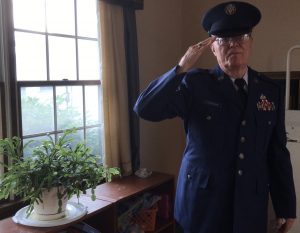
Ret. Sr. Master Sgt. James Cunningham proudly wears his uniform that still fits nearly 23 years after he was discharged. A Life of Service
Cunningham was discharged in July 1995 when he turned 60 years old. His tailor-made Air Force dress uniform still fits today at age 83; he proudly wore it in his Nassau County home, where he started a life with his late wife Mary, eight miles from where he was raised in Queens.
“I wish my wife were here to share this moment with me,” Cunningham said while visibly holding back tears. “We were married for 47 years, we didn’t quite make 50, but she was my inspiration, and as far as the service went, she was with me 100 percent.”
Mr. Cunningham has kept the last rose that was by Mary’s bedside when she passed 10 years ago. He keeps it in a tea cup with “Mary” inscribed in script. A blessing to Mr. Cunningham, the rose has not disintegrated. The rose and tea cup sit atop his living room fireplace adjacent to pictures of his loving family, including his eldest daughter who fell ill from a 9/11-related cancer as she worked on Wall Street and inhaled the smoke that engulfed Lower Manhattan.
Far from despondent, Cunningham is proud, especially of his country that has afforded him a sense of purpose, joy and gratitude. He keeps himself busy with the American Legion and Knights of Columbus organizations, while also serving as an extraordinary minister at the Church of the Blessed Sacrament, which is down the street from Cunningham’s home in Valley Stream.
“My service life endeared me for the rest of my life. It taught me things that came very handy in civilian life,” said Mr. Cunningham.
See more stories at ConnectingVets.com



